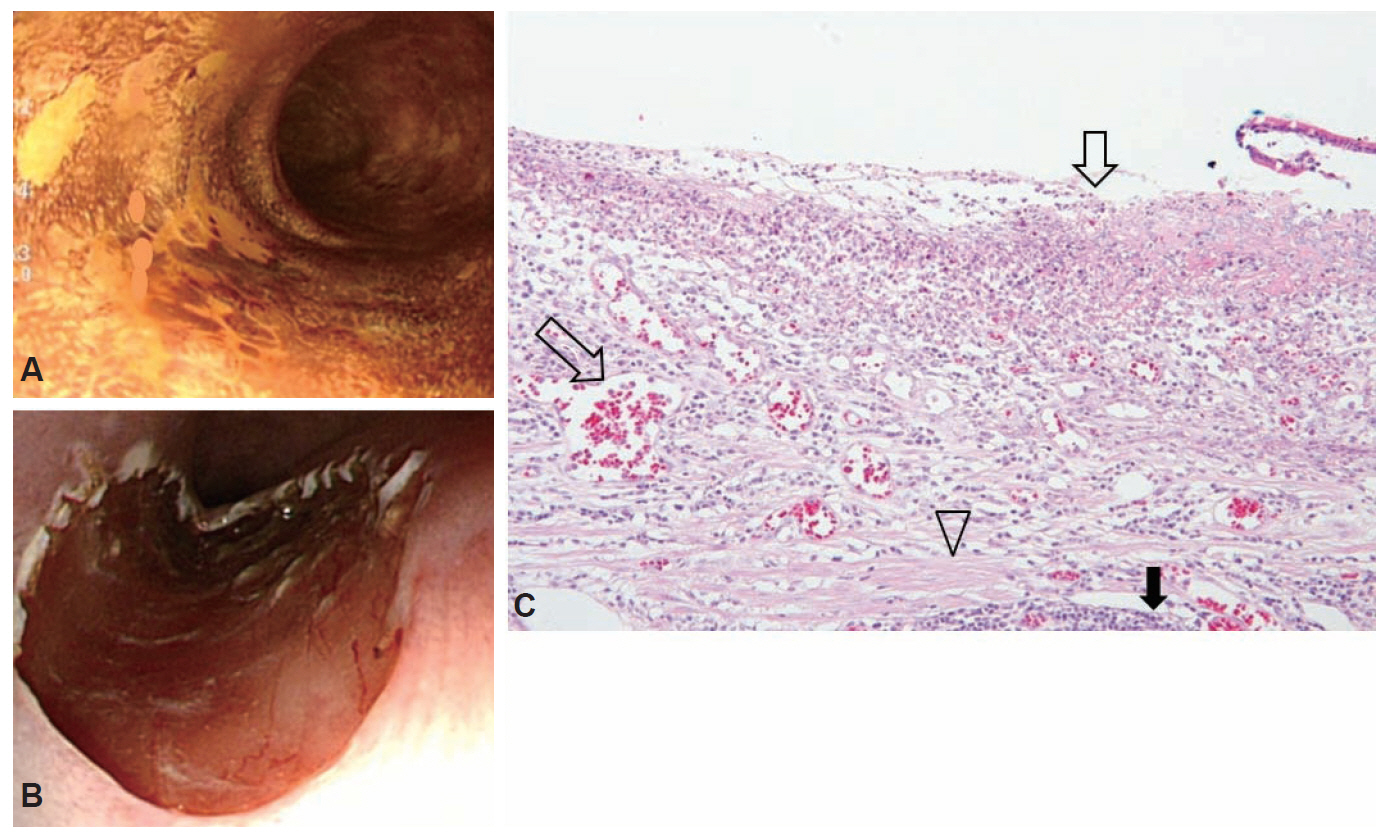Clin Endosc.
2015 Nov;48(6):553-557. 10.5946/ce.2015.48.6.553.
Endoscopic Submucosal Dissection for Recurrent or Residual Superficial Esophageal Cancer after Chemoradiotherapy: Two Cases
- Affiliations
-
- 1Department of Internal Medicine, Gangnam Severance Hospital, Yonsei University College of Medicine, Seoul, Korea. DRYOUN@yuhs.ac
- 2Department of Diagnostic Pathology, Gangnam Severance Hospital, Yonsei University College of Medicine, Seoul, Korea.
- KMID: 2380415
- DOI: http://doi.org/10.5946/ce.2015.48.6.553
Abstract
- We report two cases of endoscopic submucosal dissection (ESD) for recurrent or residual esophageal squamous cell carcinoma (ESCC) lesions after chemoradiotherapy for advanced esophageal cancer. Case 1 involved a 64-year-old man who had previously undergone chemoradiotherapy for advanced ESCC and achieved a complete response (CR) for 22 months, until metachronous recurrent superficial ESCC was detected on follow-up esophagogastroduodenoscopy (EGD). We performed ESD and found no evidence of recurrence for 24 months. Case 2 involved a 59-year-old man who had previously undergone chemoradiotherapy for advanced ESCC. He responded favorably to treatment, and most of the tumor had disappeared on follow-up EGD 4 months later. However, there were two residual superficial esophageal lugol-voiding lesions. We performed ESD, and he had a CR for 32 months thereafter. ESD can be considered a viable treatment option for recurrent or residual superficial ESCC after chemoradiotherapy for advanced esophageal cancer.
MeSH Terms
Figure
Reference
-
1. Meunier B, Raoul J, Le Prisé E, Lakéhal M, Launois B. Salvage esophagectomy after unsuccessful curative chemoradiotherapy for squamous cell cancer of the esophagus. Dig Surg. 1998; 15:224–226.
Article2. Swisher SG, Wynn P, Putnam JB, et al. Salvage esophagectomy for recurrent tumors after definitive chemotherapy and radiotherapy. J Thorac Cardiovasc Surg. 2002; 123:175–183.
Article3. Saito Y, Takisawa H, Suzuki H, et al. Endoscopic submucosal dissection of recurrent or residual superficial esophageal cancer after chemoradiotherapy. Gastrointest Endosc. 2008; 67:355–359.
Article4. Yano T, Muto M, Hattori S, et al. Long-term results of salvage endoscopic mucosal resection in patients with local failure after definitive chemoradiotherapy for esophageal squamous cell carcinoma. Endoscopy. 2008; 40:717–721.
Article5. Fujishiro M, Yahagi N, Kakushima N, et al. Endoscopic submucosal dissection of esophageal squamous cell neoplasms. Clin Gastroenterol Hepatol. 2006; 4:688–694.
Article6. Ishihara R, Iishi H, Uedo N, et al. Comparison of EMR and endoscopic submucosal dissection for en bloc resection of early esophageal cancers in Japan. Gastrointest Endosc. 2008; 68:1066–1072.
Article7. Stahl M, Stuschke M, Lehmann N, et al. Chemoradiation with and without surgery in patients with locally advanced squamous cell carcinoma of the esophagus. J Clin Oncol. 2005; 23:2310–2317.
Article8. Takeuchi M, Kobayashi M, Hashimoto S, et al. Salvage endoscopic submucosal dissection in patients with local failure after chemoradiotherapy for esophageal squamous cell carcinoma. Scand J Gastroenterol. 2013; 48:1095–1101.
Article9. Koizumi S, Jin M, Matsuhashi T, et al. Salvage endoscopic submucosal dissection for the esophagus-localized recurrence of esophageal squamous cell cancer after definitive chemoradiotherapy. Gastrointest Endosc. 2014; 79:348–353.
Article10. Mochizuki Y, Saito Y, Tanaka T, et al. Endoscopic submucosal dissection combined with the placement of biodegradable stents for recurrent esophageal cancer after chemoradiotherapy. J Gastrointest Cancer. 2012; 43:324–328.
Article
- Full Text Links
- Actions
-
Cited
- CITED
-
- Close
- Share
- Similar articles
-
- Endoscopic Submucosal Dissection Followed by Concurrent Chemoradiotherapy in Patients with Early Esophageal Cancer with a High Risk of Lymph Node Metastasis
- Endoscopic Treatment for Esophageal Cancer
- Photodynamic Therapy for Esophageal Cancer
- Salvage Endoscopic Resection for Residual Lesion after Definitive Chemoradiotherapy in Esophageal Cancer
- Superficial Esophageal Neoplasms Overlying Leiomyomas Removed by Endoscopic Submucosal Dissection: Case Reports and Review of the Literature





